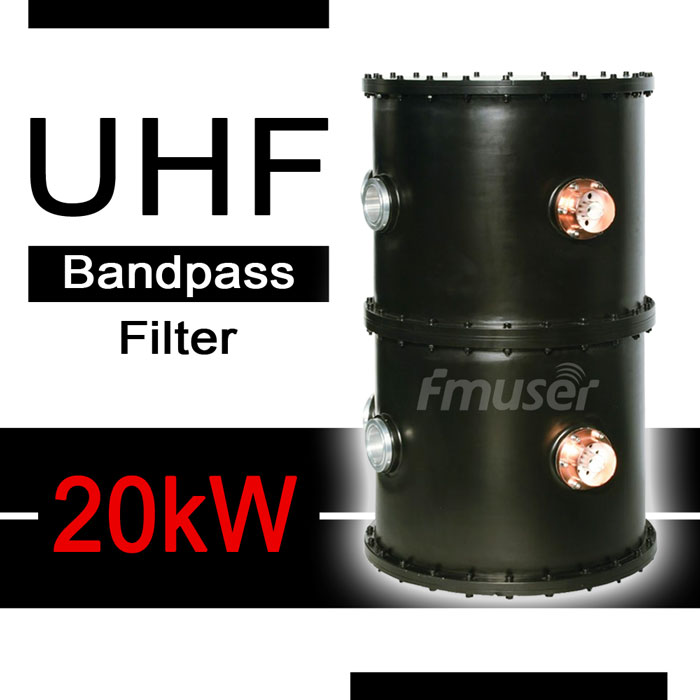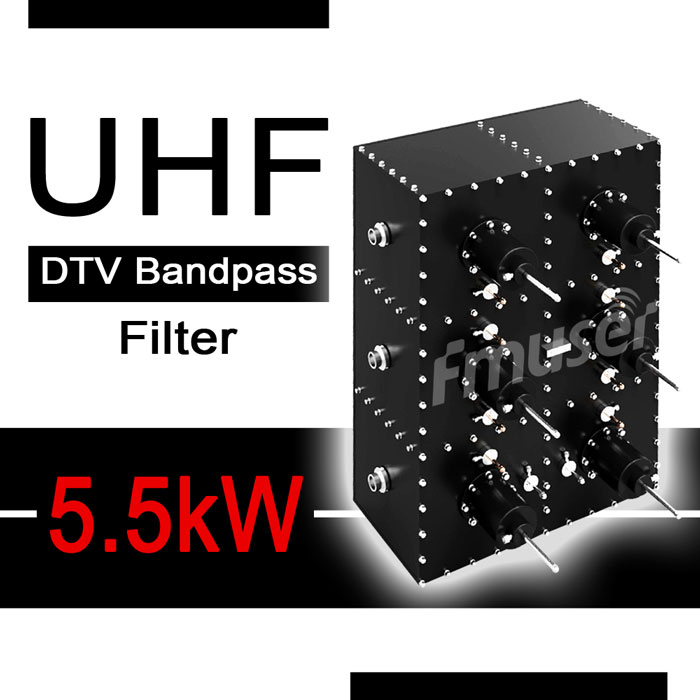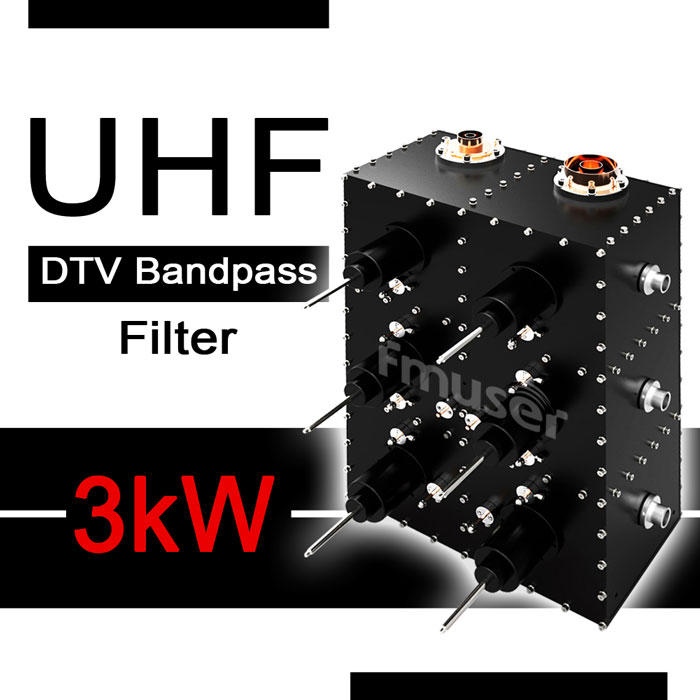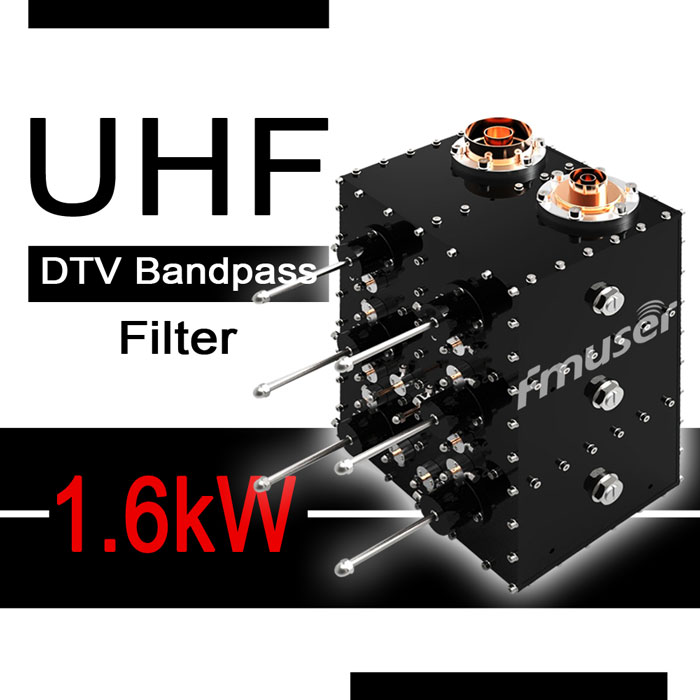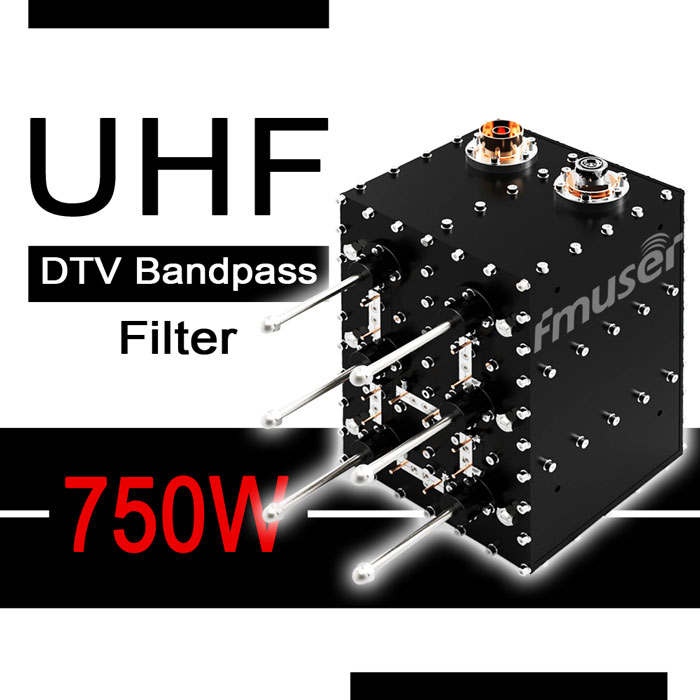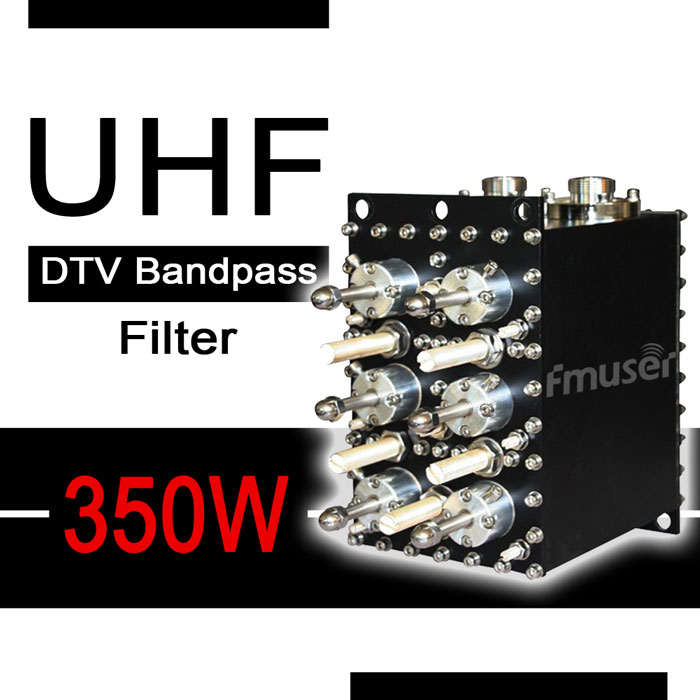
UHF Cavity Filters
UHF cavity filters are the backbone of seamless RF signal management in UHF broadcast stations, telecom infrastructure, and mission-critical communication systems. At FMUSER, we specialize in crafting high-performance RF solutions tailored to eliminate interference, amplify signal integrity, and adapt to the evolving demands of modern broadcasting.
1. Introduction & Overview: Powering Clear Signals with Precision
This page categorizes our UHF cavity filters based on frequency range (400 MHz to 3 GHz), power handling (5W to 10kW), and application-specific designs, simplifying selection for engineers and integrators targeting interference suppression, spectrum efficiency, and broadcast reliability.
2. Key Features: Engineered for Excellence
- Robust Durability: All-aluminum construction with anti-corrosion coating for 10+ years of field service.
- Certified Performance: CE, RoHS, and FCC compliance for global deployment.
- Advanced Tech: Temperature-stabilized resonators, ultra-low insertion loss (<0.5 dB), and adjustable bandwidth (±2% tuning).
- Scalable Solutions: From compact filters for small stations to industrial-grade arrays for high-power broadcast towers.
3. Diverse Applications: Solutions Built to Last
- UHF Broadcasting: FMUSER filters suppress harmonics, adjacent-channel interference, and noise in TV/radio transmitters, ensuring crystal-clear broadcasts with 99.9% signal purity.
- Military & Defense Communications: Our EMI-shielded filters protect tactical UHF systems from jamming, excelling in extreme environments (-40°C to 85°C).
- Public Safety Networks: Designed for mission-critical two-way radios, our filters enhance signal clarity in emergency response networks, reducing dropout risks.
- Cellular & Telecom Infrastructure: Optimized for 5G backhaul and repeaters, FMUSER filters minimize cross-talk in dense RF environments, boosting network uptime.
4. Why Choose FMUSER?
- Factory-Direct Pricing: Save 30-50% versus middleman-dependent suppliers.
- Always In Stock, Fast Global Shipping: 3-day delivery for standard models.
- Turnkey Solutions: Pre-configured filters with custom connectors (N-Type, BNC) or full-system integration support.
- Customization & OEM: Modify frequency, Q factor, or housing materials on demand.
- Proven Expertise: Trusted by BBC-affiliated broadcasters and Asia-Pacific telecom operators since 2012.
5. Buying Guide: Match Your Needs in 3 Steps
- Technical Specs: Define required frequency, power (e.g., 100W for FM transmitters), and VSWR (<1.5:1).
- Compatibility Check: Verify connector type and rack-mount dimensions.
- Budget Alignment: Explore FMUSER’s economical plug-and-play models or bespoke designs tailored for large projects.
-
![FMUSER 470-862 MHz 20000W UHF Bandpass Filter 20kW Compact Band Pass Filter With Custom Bandwidth for TX RX System]()
Price(USD):Ask for a quotation
Sold:31
-
![FMUSER 470-862 MHz 5500W UHF Bandpass Filter 5.5kW Digital TV DTV Band Pass Filter With Coaxial Cavities for TX RX System]()
Price(USD):Ask for a quotation
Sold:12
-
![FMUSER 470-862 MHz 3000W UHF Bandpass Filter 3kW Digital TV DTV Band Pass Filter With Coaxial Cavities for TX RX System]()
Price(USD):Ask for a quotation
Sold:16
-
![FMUSER 470-862 MHz 1600W UHF Bandpass Filter 1.6kW Digital TV DTV Band Pass Filter With High Frequency Selectivity for TX RX System]()
Price(USD):Ask for a quotation
Sold:16
-
![FMUSER 470-862 MHz 750W UHF Bandpass Filter 750W Digital TV DTV Band Pass Filter With Tunable Frequency for TX RX System]()
Price(USD):Ask for a quotation
Sold:23
-
![FMUSER 470-862 MHz 350W UHF Bandpass Filter 350W Digital TV DTV Band Pass Filter With Custom Bandwidth for TX RX System]()
Price(USD):Ask for a quotation
Sold:14
- What is an UHF cavity filter?
- An UHF cavity filter is a type of radio frequency filter used to isolate, pass, or reject radio frequencies in the ultra-high frequency (UHF) range. It consists of a combination of tuned circuits and cavities, which act as resonators. The synonym for an UHF cavity filter is an UHF bandpass filter.
- What are the most common applications of UHF cavity filters?
- The most common applications of UHF cavity filters are in radio and television broadcasting, satellite communication, radio navigation, and telemetry systems. They are used to reduce interference and improve the signal-to-noise ratio of the system. UHF cavity filters are particularly helpful in applications where a narrow frequency band needs to be isolated, such as in wireless communication systems. They are also used in WiFi and cellular networks, radio and television repeaters, radar systems, and military communication systems, among other applications.
- How to use an UHF cavity filter for TV broadcasting?
- 1. Install the filter into the antenna system following the manufacturer's instructions.
2. Ensure that the filter is properly secured and that the antenna system is adequately grounded.
3. Set the filter's passband frequency range to cover the desired broadcast frequency range.
4. Check that the filter has sufficient insertion loss to ensure that the emitted power remains within limits.
5. Monitor the filter's performance regularly to ensure that it is performing as expected.
6. Be aware of common filter problems such as out of band signals and harmonic distortion.
7. Periodically check the filter's connections to ensure that they remain secure.
8. Make sure to use a filter that is appropriate for the application, as not all filters are suited to all applications.
- How UHF cavity filter works in UHF broadcasting?
- An UHF cavity filter is used in an UHF broadcast station to reduce interference from other broadcast signals and to allow the desired signal to pass through. The filter is composed of a series of metal tubes arranged in a particular pattern, and each tube is tuned to a different frequency. The tubes are connected together inside a sealed enclosure and when the desired signal is sent through the filter, it passes through the tubes that match its frequency and is blocked by the other tubes. This ensures that only the desired signal is allowed to pass through the filter.
- Why UHF cavity filters are needed for UHF broadcast station?
- A UHF cavity filter is an important component of an UHF broadcast station because it prevents the signal from the station's transmitter from interfering with other signals on the same frequency. It also prevents signals from other transmitters on different frequencies from interfering with the signal from the station's transmitter. A UHF cavity filter is necessary for an UHF broadcast station because it helps ensure that the station's signal is strong and clear, without interference from other signals.
- What are types of UHF cavity filters and their differences between?
- There are three main types of UHF cavity filters: Bandpass, Notch (Bandstop), and Highpass.
Bandpass filters are designed to pass only a specific frequency range, or “band”, of signals while blocking all other frequencies.
Notch (Bandstop) filters are designed to block a specific frequency range, or “band”, of signals while passing all other frequencies.
Highpass filters are designed to pass high frequencies while blocking low frequencies.
Before placing a final order, how to choose the best UHF cavity filter for an UHF broadcast station?
- How to choose the best UHF cavity filters?
- 1. Identify the exact frequency range and bandwidth required.
2. Determine the power handling requirements.
3. Consider the type of filter needed (low pass, high pass, band pass, etc.).
4. Consider the insertion loss, return loss, and rejection specifications.
5. Determine the environmental requirements (temperature, humidity, etc.).
6. Research the brands available and compare their specifications to find the best option.
7. Compare the price of the product and find the most cost-effective solution.
8. Consider any additional features or design characteristics that may be necessary.
9. Check the product reviews and feedback from other customers.
10. Contact the manufacturer or supplier to ensure the product is compatible with your system.
- How to connect an UHF cavity filter correctly?
- 1. Install the filter according to the instructions provided with the filter.
2. Connect the filter’s input (“IN”) to the transmitter’s output.
3. Connect the filter’s output (“OUT”) to the antenna.
4. Perform a sweep test to ensure that the filter is properly connected and performing correctly.
5. Monitor the filter’s performance during normal operation and adjust as necessary.
- What are the equipment related to UHF cavity filter?
- 1. Cavity Filter: This is the main component of the UHF cavity filter system. It is a metal housing with a set of tuned circuits designed to pass UHF frequencies.
2. RF Amplifier: An RF amplifier is used to boost the signal strength before it is fed into the cavity filter.
3. RF Switch: An RF switch is used to select the desired UHF channel for transmission.
4. Antenna: An antenna is used to transmit the UHF signal to the receiving location.
5. Transmission Line: A transmission line is used to connect the UHF cavity filter to the antenna.
6. Power Supply: A power supply is used to provide the required power to the UHF cavity filter.
- What are the most important specifications of an UHF cavity filter?
- Physical Specifications
- Size: UHF cavity filters come in a variety of sizes, depending on the frequency range and type. The size of the filter will depend on the number of cavities used in the filter.
- Insertion Loss: This is the loss of signal strength as the signal passes through the filter. It is typically measured in decibels (dB).
- Return Loss: This is the amount of energy reflected back into the filter when a signal is sent through. It is measured in decibels (dB).
- Bandwidth: This is the range of frequencies that the filter can pass through. The bandwidth is typically measured in hertz (Hz).
RF Specifications
- Center Frequency: This is the frequency at which the filter will pass the most amount of energy. It is typically measured in hertz (Hz).
- Attenuation: This is the amount of energy that the filter will block at different frequencies. It is typically measured in decibels (dB).
- Rejection: This is the amount of energy that the filter will block outside of the desired frequency range. It is typically measured in decibels (dB).
- Group Delay: This is the amount of time it takes for a signal to pass through the filter at different frequencies. It is measured in seconds (s).
- How to maintain an UHF cavity filter as a boadcast engineer?
- 1. Check power levels of the system.
2. Inspect the UHF cavity filter for dust, dirt, corrosion, and other debris.
3. Ensure that the filter is properly seated and connected to the antenna system.
4. Test the filter’s performance with a spectrum analyzer.
5. Clean the filter with a soft brush and compressed air.
6. Measure the insertion loss and return loss of the filter.
7. Inspect the filter’s tuning screws to ensure they are set correctly.
8. Check the filter’s temperature and humidity.
9. Test the filter with a signal generator to ensure it is working properly.
10. Ensure that the filter’s noise figure is within acceptable levels.
- How to properly repair an UHF cavity filter?
- Repairing an UHF cavity filter can be done in a few steps. First, it is important to diagnose the problem. A visual inspection of the filter and its components should be done to check for any broken parts, loose connections, or any other signs of damage or malfunction.
If broken parts are found, it is important to determine the cause of the failure before replacing the damaged components. If it is determined that the problem is due to a manufacturing defect or mechanical failure, then the parts should be replaced with new ones.
Once the faulty parts have been replaced, the filter should be reassembled according to the manufacturer's instructions. This may include re-connecting the various components and adjusting any settings on the filter.
Finally, the filter should be tested to make sure it is functioning correctly. If any issues are found, the process should be repeated until the filter is correctly functioning.
- How to correctly pack up an UHF cavity filter before and after delivery?
- 1. Choose a packaging material that is anti-static, waterproof, and shockproof.
2. Choose a package that is well-padded and will provide adequate protection during transport.
3. Make sure the packaging is sealed properly to prevent the entry of any moisture or contaminants.
4. Make sure the package is labeled properly and clearly indicates the contents.
5. Make sure the package is properly sized for the item being shipped.
6. Make sure the package is securely strapped or secured to prevent any shifting during transit.
7. Make sure to include any necessary documentation or certificates required for the item being shipped.
8. Make sure to consider any additional requirements for shipping or handling the item, such as temperature or vibration restrictions.
- What is an UHF cavity filter casing made of?
- The casing of a UHF cavity filter is typically made of dielectric material, such as ceramic, glass, or plastic. This dielectric material is important for the filter's performance, as it determines the amount of energy that passes through the filter. If the wrong material is used, the filter may not be able to filter out the desired frequencies, resulting in poor performance. Additionally, the type of material can affect the filter's insertion loss, return loss, and other performance parameters.
- What is the basic structure of an UHF cavity filter?
- The basic structure of an UHF cavity filter consists of four main parts: the coupling post, the resonators, the iris, and the output.
The coupling post provides the electrical connection between the input and the output of the filter. It is also used to adjust the amount of power that is coupled between the input and output of the filter.
The resonators are the main components of the filter. They are used to achieve the desired frequency response characteristics.
The iris is an adjustable metal plate that is used to tune the frequencies of the filter. It is typically used to achieve a more narrow response over a specific frequency range.
The output is used to provide an electrical connection to the output of the filter.
The performance and attributes of the filter are determined by the combination of the components, their design, and the tuning of the iris. Without any of these structures, the filter cannot work normally.
- How to properly operate an UHF cavity filter?
- The person assigned to manage a UHF cavity filter should have a good understanding of electronics and be familiar with radio-frequency (RF) measurements, particularly in relation to the operation of the filter. They should also be knowledgeable in the use of test and measurement equipment, as well as in the principles of antenna design and filter tuning. They should also have experience with UHF broadcast systems and be able to troubleshoot any problems that may arise.
- How are you?
- I am fine
CONTACT US


FMUSER INTERNATIONAL GROUP LIMITED.
We are always providing our customers with reliable products and considerate services.
If you would like to keep touch with us directly, please go to contact us
